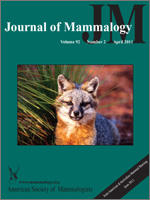Wolves (Canis lupus), as both opportunistic and specialist predators, can limit and regulate ungulate dynamics. As part of understanding predator–prey interactions in the largely undisturbed system of the Besa-Prophet area in northern British Columbia, we used stable isotopes of carbon and nitrogen to infer seasonal diets of 5 wolf packs. We selected the hair, tissue, or blood sample of each prey species that could best index within-season diet composition. Seasonal isotopic differences for a given sample type were as much as 0.28‰ δ13C and 0.97‰ δ15N. The large biomass species of moose (Alces americanus) and elk (Cervus elaphus) dominated the diets of wolves, but caribou (Rangifer tarandus) and Stone's sheep (Ovis dalli stonei) also were locally or seasonally important to some packs. Mean isotopic determinations of summer food habits were correlated positively (P < 0.001) with proportions of prey by species determined from scat samples. This general agreement lends support for the tissue to diet discrimination values used in the Bayesian modeling and indicates that the longer-term dietary estimates from stable isotopes were reflective of shorter-term recent ingestion. Although moose have been assumed to be the most important prey item for wolves throughout the year in northern British Columbia, our results indicate that dietary dynamics of wolves in the Besa-Prophet area are more complex than previously reported.
How to translate text using browser tools
15 April 2011
Using stable isotopes to define diets of wolves in northern British Columbia, Canada
Brian Milakovic,
Katherine L. Parker
ACCESS THE FULL ARTICLE

Journal of Mammalogy
Vol. 92 • No. 2
April 2011
Vol. 92 • No. 2
April 2011
diet
food habits
prey selection
scat samples
stable isotopes
wolves




